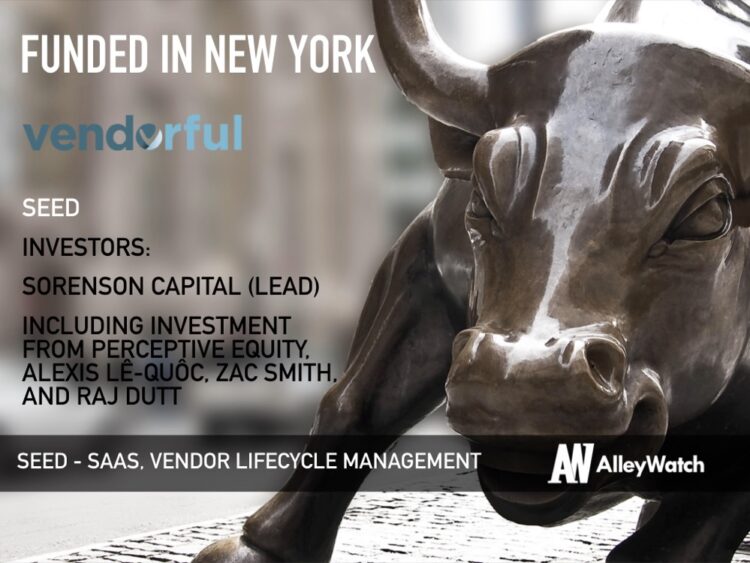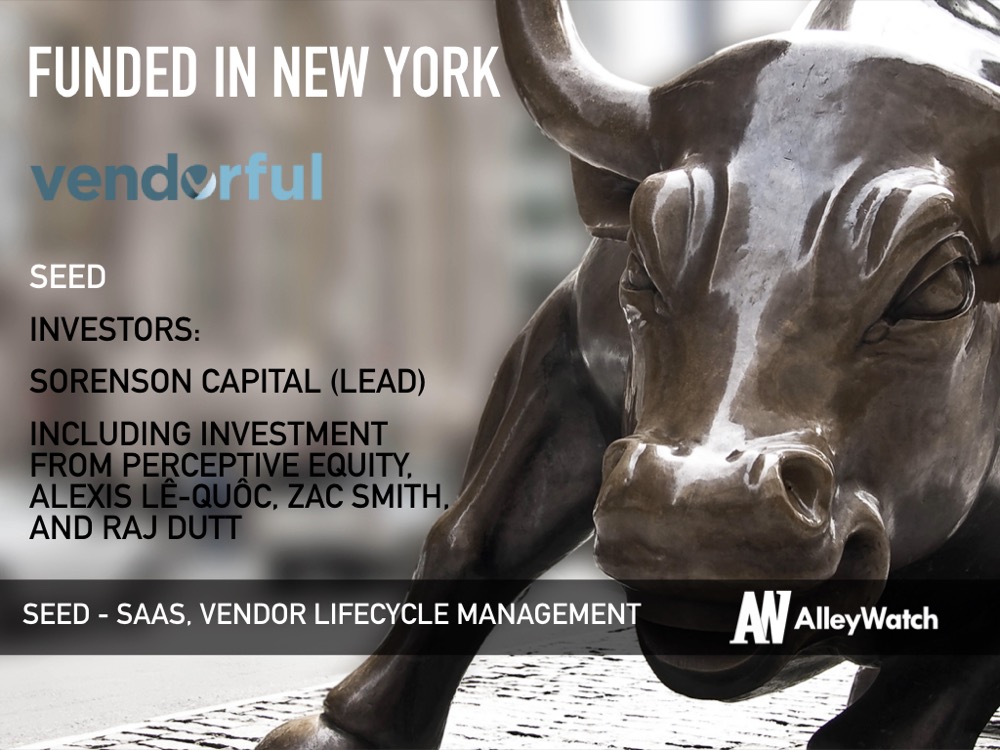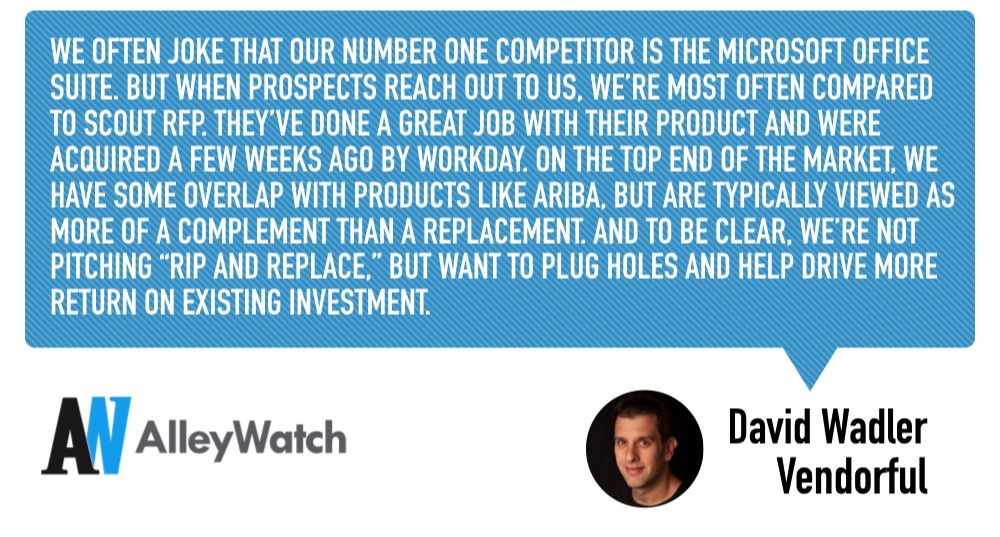Finding a great supplier is challenging, and procurement teams know that a great, long-term relationship with a supplier can have a positive, ripple effect across the company. Vendorful is the Vendor Lifecycle Management solution that helps procurement teams every step along the way from RFP’s to managing contracts. It easily integrates with existing eProcurement suites or with data sources like Excel and Word. Vendor has a host of functions that include the ability to fully customize vendor attributes and track performance trends.
AlleyWatch interviewed David Wadler about Vendorful’s recent seed round and what makes this software unique.
Who were your investors and how much did you raise?
This was a seed round that included the conversion of some existing convertible debt. The round was led by Sorenson Capital with additional investment from Perceptive Equity and included various others, including NYC tech founders Alexis Lê-Quôc (DataDog), Zac Smith (Packet), and Raj Dutt (Grafana Labs). We left a bit of room in the round and can take up to $2.25M in this round and the rest of the reported amount is from debt that converted into equity.
 Tell us about the product or service that Vendorful offers.
Tell us about the product or service that Vendorful offers.
Vendorful is a SaaS solution that streamlines Vendor Lifecycle Management. This is a process that begins with strategic sourcing (RFPs, etc.) and continues through vendor onboarding, evaluating ongoing performance of the vendor, keeping vendor data up to date, managing the expiration/renewal of contracts, etc. We have modules for all these as well as other complementary modules to help organizations reduce cost and risk while improving alignment with their suppliers.
What inspired the start of Vendorful?
My partner, Peter Bonney, and I come from different backgrounds. He spent a career in finance while I’ve spent the majority of my time in software. One major commonality in our respective experiences is that we’ve seen a ton of money that was effectively incinerated by poor process.
How is Vendorful different?
The tooling for the processes that Vendorful addresses is bifurcated. On the one hand, you have expensive, complex enterprise products that seemingly require a Ph.D. to use. On the other hand, you have Word, Excel, and email. From the beginning, we set out to challenge convention. First, we wanted to have a product that is incredibly easy to use. And to that end, we’ve reduced much of these cumbersome processes to point and click. Second, interoperability was very important as we see best-of-breed approaches generating serious traction in other verticals. Consequently, everything we develop is API first.
What market does Vendorful target and how big is it?
We’ve had surprising traction in large enterprises and have embraced that segment of the market. But at our price point, we can deliver an enterprise-class product into the mid-market so the addressable market, depending on how you define that segment, is many tens of thousands up to around 200,000 businesses in the U.S. alone. Plus, we work with non-profits, governments, etc.
Who do you consider to be your primary competitors?
We often joke that our number one competitor is the Microsoft Office Suite. But when prospects reach out to us, we’re most often compared to Scout RFP. They’ve done a great job with their product and were acquired a few weeks ago by Workday. On the top end of the market, we have some overlap with products like Ariba but are typically viewed as more of a complement than a replacement. And to be clear, we’re not pitching “rip and replace,” but want to plug holes and help drive more return on existing investment.
What’s your business model?
SaaS.
What was the funding process like?
Much, much, much better than my first time around. The ecosystem in the NYC area has evolved considerably. Plus, having started a software company and led it through acquisition, I’m personally more of a known quantity. My partner and I are both angel investors as well, which really informed our approach.
What are the biggest challenges that you faced while raising capital?
We had a bit of a disconnect between the amount of money we wanted to raise and the number of people who were interested in investing. We have personal relationships with almost all of our investors and were inclined to say, “Yes,” when they expressed interest. However, we had to really work to make sure that we raised an amount that stayed inside the parameters we established.
What factors about your business led your investors to write the check?
It varied a great deal. Many were excited about our addressing a large, underserved market. Others didn’t care so much about those details and were placing bets on our team to deliver a win.
What are the milestones you plan to achieve in the next six months?
Before raising money, we were tracking to profitability in a few months. Now, the goal is to swap that target for accelerated growth. And to do that, we’ll need to add to our great time. If all goes well, we’ll double in size over the next six months while continuing to advance the product and grow our top line.
If all goes well, we’ll double in size over the next six months while continuing to advance the product and grow our top line.
What advice can you offer companies in New York that do not have a fresh injection of capital in the bank?
All startups involve optimizing against constraints. It seems like you can always find a deep-pocketed incumbent or a better-funded disruptor. If you figure out what people want and give it to them, you’ll get validation and revenue. Wash, rinse, repeat. If you do this enough, you’ll be fundable, but may not even need outside capital.
Where do you see the company going now over the near term?
Startups go through stages. Idea. Product. Product validation. Commercial validation. Traction. Growth. We’re fully into the traction stage now.
What’s your favorite restaurant in the city?
Osteria Cotta on the UWS. Since I have young children, I have to optimize for distance and quality. Cotta really fits the bill on both counts.





